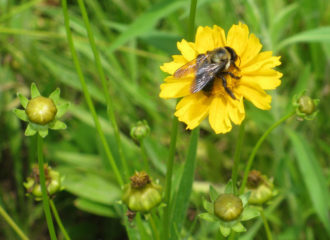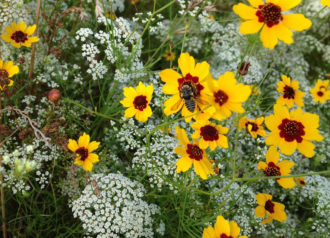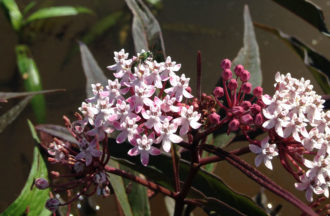FAYETTEVILLE, Arkansas – It’s not uncommon for wetlands, especially those enrolled in federal conservation programs, to be actively managed for plant diversity and wildlife habitat. But University of Arkansas researchers have found an additional reason to maintain these ecosystems, particularly when they occur adjacent to croplands: many pollinators call them home.
In a Southern Sustainable Agriculture Research & Education (SSARE) Graduate Student study, researchers compared pollinator communities between managed emergent wetlands and adjacent soybean fields in the lower Mississippi Alluvial Valley of Arkansas and found that many pollinator species that fed on plants in wetlands also visited crop fields, suggesting they were using flowering soybean plants as an additional nectar source.
“Pollinator communities that use emergent wetlands have been poorly documented and their benefits to plant communities on surrounding lands are not fully understood,” said Phillip Stephenson, associate wildlife biologist and student liaison of The Wildlife Society. “We believe these restored emergent wetlands serve as a refuge for invertebrate communities, while promoting groundwater recharge and soil retention, and providing habitat to a range of flora and fauna. These conservation easements also provide a “free source” of pollinators to surrounding croplands by promoting native bee habitat and biodiversity.”
Emergent wetlands are moist soil areas made up of diverse plant communities of annuals and perennials, generally including grasses, sedges, and forbs. More than 20 percent of the land mass in Arkansas was once covered wetlands, but was converted to agricultural land leaving a fragmented mosaic of isolated wetlands surrounded by intensive agricultural production. Arkansas now only has 8 percent of its land mass covered in wetlands.
Stephenson said the purpose of the project (GS15-143), “Pollinator Communities on Native Emergent Wetlands, Managed Emergent Wetlands, and Adjacent Croplands in the Lower Mississippi Alluvial Valley of Arkansas,” was to identify the impact of native bees that use emergent wetlands on adjacent crop fields as an alternative pollinator service to the declining honey bee population.
Stephenson and entomologist Erik Ostrum sampled four paired emergent wetland and soybean fields and collected bees using a variety of trapping methods. They captured over 2,000 individual bees made up of 37 species in the soybean fields; and over 900 individual bees made up of 34 species in the adjacent emergent wetlands. The most abundant bees captured include the green sweat bee (Augochlorella aurata), rose-mallow bee (Ptilothrix bombiformis), common long-horned bee (Melissodes communis), brown-winged long-horned bee (Melissodes comptoides), and the black long-horned bee (Melissodes bimaculata).
“Both soybean fields and emergent wetlands supported similar species richness,” said Stephenson. “Solitary bees were documented in emergent wetlands at lower quantities than in adjacent soybean fields during the same collection timeframe indicating a movement from the emergent wetlands into the soybean fields. Although bee abundances collected were not significantly different, we would argue that bees were taking advantage of the supplemental resource soybean flowers provide during bloom.”
Researchers in this study also found that solitary bees traveled a greater distance than honey bees, bees were collected up to 150 meters into soybean fields, and were of a higher abundance than honey bees.
“Honey bees are known for their abilities to travel great distances to forage, but their native bee counterparts are often over looked and understudied,” said Stephenson. The study found that native bees outnumbered honey bees in the soybean fields by a ratio of 81 to 1.
The research results, he said, reiterate the importance of maintaining managed and restorated natural areas adjacent to croplands to promote native bee populations. The study is one of the few to document bee communities in emergent wetland systems and is also a rare endeavor to study emergent wetland bee communities and their interactions with adjacent soybean fields.
Published by the Southern Region of the Sustainable Agriculture Research and Education (SARE) program. Funded by the USDA National Institute of Food and Agriculture (NIFA), Southern SARE operates under cooperative agreements with the University of Georgia, Fort Valley State University, and the Kerr Center for Sustainable Agriculture to offer competitive grants to advance sustainable agriculture in America's Southern region. This material is based upon work that is supported by the National Institute of Food and Agriculture, U.S. Department of Agriculture, through Southern Sustainable Agriculture Research and Education, under sub-award number: GS15-143. USDA is an equal opportunity employer and service provider. Any opinions, findings, conclusions, or recommendations expressed in this publication are those of the author(s) and do not necessarily reflect the view of the U.S. Department of Agriculture.


